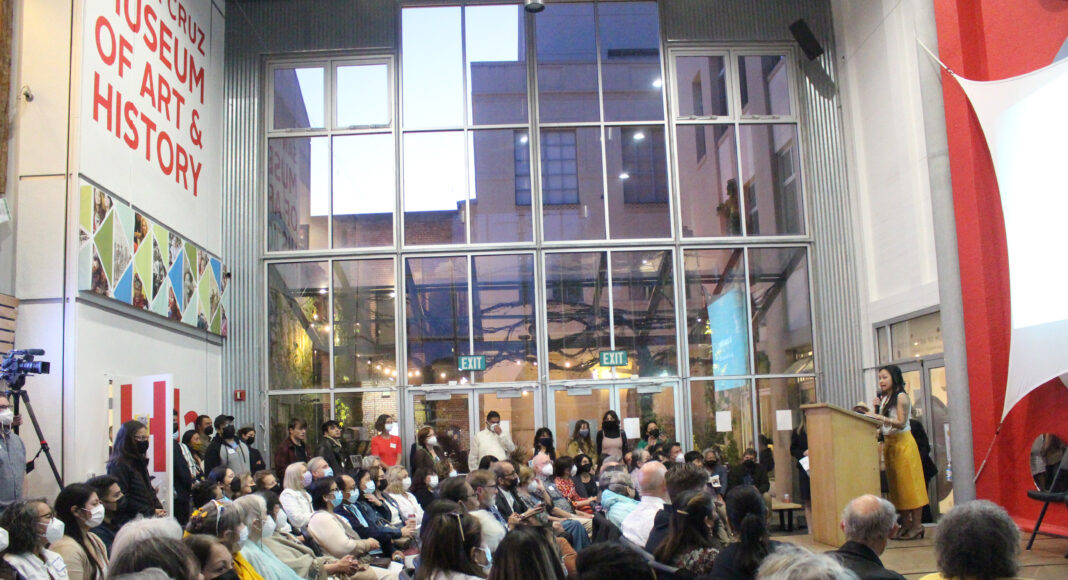Hundreds of visitors flocked to the Santa Cruz Museum of Art & History (MAH) on April 9 to celebrate the launch of a new digital history archive.
The Watsonville is in the Heart (WIITH) Digital Archive aims to preserve the histories and contributions of Filipino Americans in the Pajaro Valley. Kickstarted by the work of the Tobera Project in 2019, the creation of the archive was led by UC Santa Cruz (UCSC) grad students Christina Ayson Plank, Meleia Simon-Reynolds and a team of undergraduates. So far, the ever-growing archive includes 689 objects from 12 family collections, with oral histories, photographs, artifacts, family heirlooms, newspaper articles and more.
“This is almost two years of work for us,” says Dr. Steve McKay, associate professor of Sociology at UCSC and co-coordinator/principal investigator for WIITH. “This feels like a culmination, but it also definitely feels like a launch. This is the first time families are getting a chance to see everything … They’ve known there’s a project going on, but hadn’t seen the fruits of that. This is the first time they all get to be together, and see what we’ve been doing.”
The Tobera Project is a local initiative aiming to preserve and honor Watsonville’s Filipino history, led by community organizer Roy Recio, Jr. The project has steadily been growing, piecing together histories from the families of the Manongs—the first generation of Filipino immigrants to arrive in the U.S. in the 1920s and ’30s.
“It’s been such a beautiful experience,” Recio says. “The last three years have been amazing. For many of us, honoring and preserving our heritage on the central coast has really been a dream come true. We’ve planted a seed, and that seed has been flourishing, with community involvement and a lot of hard work and dedication.”
WIITH began with an annual fundraising calendar and an exhibit in early 2020 at the Watsonville Public Library.
“Roy said he was putting together an exhibit, and was wondering if UCSC would help,” McKay says. “I jumped at the chance. As someone who teaches at a public university, we feel we should be of service to the public. And who better to serve than the people of the Pajaro Valley?”
Along with co-coordinator Dr. Kathleen Gutierrez, McKay eventually brought Plank and Simon-Reynolds on board, and soon the idea for an online archive was formed.
“And a couple thousand emails and many meetings later, we made it here,” McKay says.
The April 9 event included speeches and presentations by organizers and supporters. Plank and Simon-Reynolds revealed the archive, showing guests how to navigate the new site. The Tobera Project also held the fourth panel in its Talk Story series, with three WIITH contributors discussing the history of Filipino women in the Pajaro Valley.
UCSC Dean of Humanities Dr. Jasmine Alinder congratulated the Tobera Project and thanked them for including UCSC students in the work.
“Launching a digital archive is an important accomplishment,” Alinder says. “But it’s just the beginning. The beauty of a digital archive lies in its accessibility, in different ways of how it can be used by different people. The Tobera Project and Watsonville is in the Heart serve as a model for transformative power.”
The launch of the archive is just the beginning. The next step, Simon-Reynolds says, is working with the Pajaro Valley Unified School District on its new ethnic studies curriculum for high schoolers. They will work with teachers to develop targeted lessons, educational resources and more.
“We want to find a way to get these stories, these local community histories into those classrooms, “ she says. “That’s the next phase of this project.”
WIITH will once again be joining forces with the MAH for a full-blown art and history exhibit in 2024. The in-person show will include artifacts from the archive, as well as original artwork inspired by the project.
Recio also announced that the Tobera Project has raised $25,000 for the creation of a mural in downtown Watsonville. The piece will be part of Watsonville Brillante, a massive mural project spearheaded by artist Kathleen Crocetti. It will feature an image of Fermin Tobera, the young Filipino man who was shot and killed during the Watsonville riots in January 1930.
“We don’t have anything—nothing in town to honor Fermin, or Filipinos in general,” Recio says. “This is a long time coming.”
The large crowds at the MAH on April 9 were a pleasant surprise to many of the organizers.
“It’s incredible—I can’t believe it,” says Simon-Reynolds. “I mean, you wouldn’t think that an online archive launch would have such a large draw, but it does. People are really excited.”
Adds McKay: “We’re super happy to see everyone here. Some who are represented brought 15 of their family members tonight to share their histories. We’re so honored to be part of it.”
To view the Watsonville is in the Heart Digital Archive, visit wiith.ucsc.edu. For information on the Tobera Project, visit toberaproject.com.












